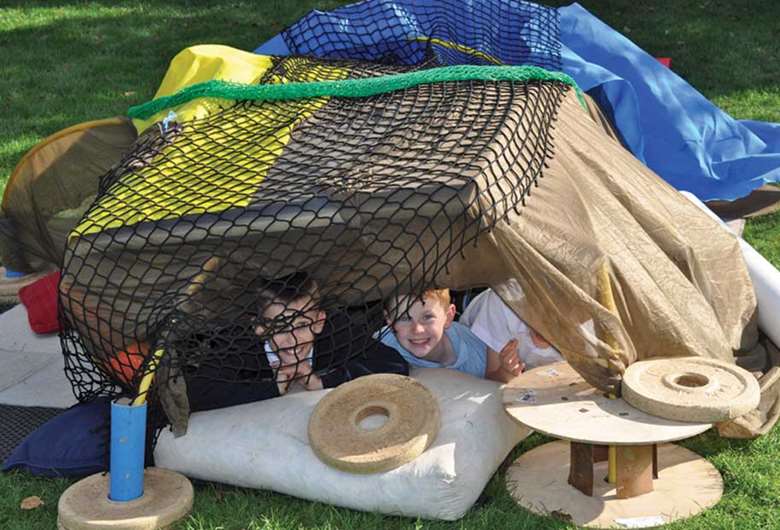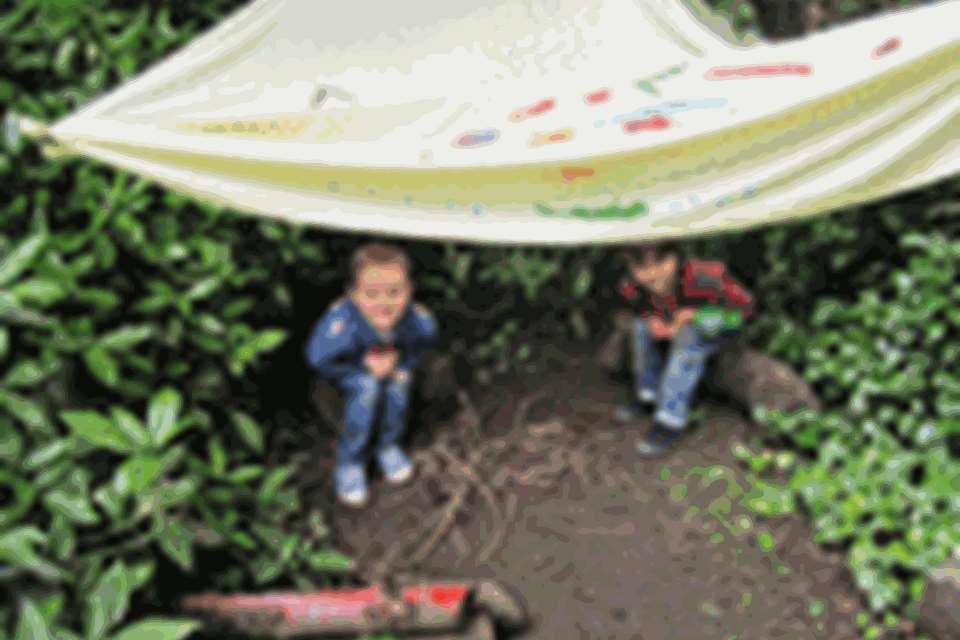Enabling Environments: Dens - Secret places
Ruth Thomson
Monday, September 8, 2014
With a view to introducing den play at her school, Louise Nicholls carried out a research project looking at the impact this type of play can have on young children. She shares her findings.

What effect, if any, does den play have on the way pre-school children learn and develop? And, more particularly, how does den play affect children's social, fine motor and language development? These were the main questions that I sought to address in my MA dissertation, and although my study was small I feel it provides an illuminating insight into the benefits of den play.
Research on the subject is remarkably limited, but my study was informed by the view of Sobel, who suggests that 'a den is the child's chance to create a home away from home that is secret and becomes a manifestation of who they are. The den is the chrysalis out of which the butterfly is born' (Barnard, 2006).
I have a particular interest in outdoor play and learning, but my decision to research den play stemmed from an outdoor learning training day focusing on this very subject. On the day, we were presented with a variety of resources and asked to work in groups to build a den.
The exercise required us to work together socially, to discuss and problem solve and be physical. But most importantly it was an enjoyable experience. The process reminded me of my childhood making dens with my mother's clothes horse and sheets, and how much I used to like playing in the dens that I had created.
I wanted to introduce den play at my school, but first wanted to justify its potential to colleagues through some research. There was also a pre-school manager on the course who was interested in den play, so we agreed to use her setting as my case study.
The research took place over five months, using observations of eight children, interviews with the pre-school manager and an interview with children as the three methods of data collection. I also focused in particular on two of the children in the group of eight. The mix of four girls and four boys, who had shown interest in den play, were chosen randomly from the pre-school's 45-50 month age group.
SOCIAL DEVELOPMENT
Over the course of the study, I found that both the two focus children engaged with a growing number of playmates during the den-playing sessions, which suggests a positive effect on their social development.
The children seemed to develop socially as they discussed how they were going to make the den and shared their ideas. This supports the research of Powell (2001) who observed that playing with 'forts' provided training in social competence, for example when children had to come to an agreement on who should decide how they should co-operate to make a 'fort' (cited in Kylin, 2003).
Once the dens were made, it was fascinating to watch the children's imaginations develop as their den became the special place that they had created. My observations showed that all of the children were involved in role play once their dens were made and there also seemed to be a correlation between the amount of children playing in the den and the type of role play that occurred. The role play certainly lasted longer and became more intense when there were more children involved. In addition, as Jenkinson asserts, 'children engrossed in play are learning constantly' (Jenkinson, 2001).
Some of the children's comments during the interview showed their awareness of needing to play with more children to engage in the kind of games they wanted to play. This adds to earlier research that found that during pretend play children's social interactions were more enjoyable, lasted longer, involved larger groups, and showed more play involvement and greater reciprocity (Connolly, 1998).
LANGUAGE DEVELOPMENT
My study also suggests that there is potential for children's language to develop when involved in den play. The findings show a particular increase in the amount of language used once the dens were made and the children then became involved in imaginative role play.
This supports a comment by Moyles, who asserts that, 'A particular and sometimes underrated context for the development of language, communication skills and competence is in the area of pretend play, which is often accompanied by complex language interactions' (Moyles, 1992).
Other researchers, such as Levy, Wolfgang and Koorland (1992), found that there is a functional relationship that exists between enriched socio-dramatic play and an increase in levels of language performance. Similarly, a study by Levy, Schaefer and Phelps (1986) supports the idea that participation in socio-dramatic play builds the language competence of young children.
It is possible that language within den play is greater because it is a 'special place', 'a place filled with meaning and where the children involved themselves in special games and activities' (Kylin, 2003).
Certainly, a study into young children's language by Tizard and Hughes (1984) confirms that 'children's utterances are better in every way ... when the children are in a familiar environment' (MacNaughton et al, 2005), and perhaps the children's den becomes this 'familiar environment'.
FINE MOTOR DEVELOPMENT
My findings suggest that the children became more competent at using fine motor skills during the den-play sessions, particularly after having help initially from an adult. Adult involvement seemed to be important, particularly when helping the children initially to manage the den-play fastenings. Through the process of watching an adult and having a little bit of help, they were then able to have a go themselves.
This relates to the arguments of Bruce, who suggests that, 'through watching others with more experience and expertise the child makes use of and reconstructs an event after the event' (1997, cited in Edgington, 2004). It also supports Vygotsky's view that 'what a child can do with assistance today she will be able to do by herself tomorrow' (Vygotsky, 1978).
GENDER
As with many research studies, there were some findings that were surprising, and the one particular area that I found fascinating was that of gender. In all eight observations I found that the children made and played in their dens in groups according to their gender. I also found, like the research by Dixon and Day (2004), that there were clear distinctions between the types of den play that children carried out, depending on their gender.
In my observations, the girls tended to make their den into a home with bedrooms, kitchen area and even shoe storage, while the boys tended to use their den for more action-type games, particularly in the fourth observation where the boys' den became a 'baddy trap'.
Research by Cullen (1993) found that when playing outdoors, 'boys played with the more active equipment and girls tended to stay with the quieter home-type play' (White, 2008). Similarly, Hart (1979) and Sobel (1993) emphasise girls' greater interest in the insides and furnishings of dens, and the fact that many of their games are related to playing house, and boys' greater interest in the outside and construction itself.
Sobel believes that for girls 'there is a fascination with making things orderly and right. By putting everything in order in a small, manageable world, these girls are creating a place for themselves in the larger world' (2011). Whether these behaviours are more to do with 'nature' or 'nurture' is a question that lies beyond the present study.
FUTURE RESEARCH
My study, of course, has its limitations - it was small, short term and had a narrow focus. However, the biggest obstacle for me was the lack of den-play research, which made it very difficult, if not impossible, to make comparisons with other researchers and research-study findings. Clearly, more research into den play is needed to discover its true potential, and to consolidate and extend my own findings.
On balance, I am confident that my chosen research method was an illuminating one and hope the findings of my study will benefit practitioners wanting to develop den play within their settings.
I also hope that the value of outdoor learning will continue to be recognised by early years providers and Government ministers, particularly when considering that 'changing social and environmental contexts in recent decades has impacted on children's prospects for outdoor play' (Little and Wyver, 2008).
Louise Nicholls is an early years teacher at William Gilpin CE Primary School, Lymington, and has an MA in education.
[asset_library_tag 543,Download the PDF]







